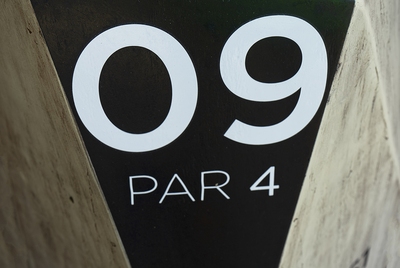 If you are a fan of golf or even if you are simply familiar with the basic terminology of the sport, you might wonder why the term “under par” means something good in golf while the term “sub par” means something bad in other walks of life.
If you are a fan of golf or even if you are simply familiar with the basic terminology of the sport, you might wonder why the term “under par” means something good in golf while the term “sub par” means something bad in other walks of life.
That’s a coincidence because we were wondering the same thing ourselves. And we became so curious about this apparent contradiction that we decided to investigate.
In this article, we’ll explain why sub par means something negative in general terms but under or below par is actually something to aim for in golf. We’ll delve into the etymology of the word “par” and we’ll also attempt to establish when it was first used in golf and how being under par became something good.
First, though, in case you are not entirely familiar with the concept, we will explain what par means in golf.
What Is Par In Golf?
 Let’s start with the very basics of golf, i.e. players use golf clubs to hit their golf ball around the course with the aim of getting said ball into the holes in as few shots as possible. A conventional golf course contains 18 holes (though there are other sizes of course, such as nine-hole courses). Each hole consists of a teeing ground or area (from which the first shot of the hole must be played and a putting green (the area that contains the actual hole or cup into which the ball must be hit).
Let’s start with the very basics of golf, i.e. players use golf clubs to hit their golf ball around the course with the aim of getting said ball into the holes in as few shots as possible. A conventional golf course contains 18 holes (though there are other sizes of course, such as nine-hole courses). Each hole consists of a teeing ground or area (from which the first shot of the hole must be played and a putting green (the area that contains the actual hole or cup into which the ball must be hit).
Most holes also include fairways of well-kept grass between the tee and the green, with rough (longer grass than the fairways) bordering the fairways, while various hazards such as bunkers (sand traps), ponds or streams, rocks or trees could also be situated on a given hole.
The score a player makes on a given hole simply refers to how many shots it takes them to get the ball from the tee to within the hole. Each hole is given a par score, which usually varies between three and five; the pars of each hole on a given course are added together to give the par score for a complete round (which on an 18-hole course is usually around the 72 mark). The par score for each hole represents the expected number of shots a good player will take to get the ball in the hole. When we say a “good” player, we are referring to a player whose average score for a round of golf is equal to or less than par. Such a player is referred to as a scratch player or someone with a zero handicap.
Given that golfers aim to complete holes and courses in as few shots as possible, from a golfing perspective, being “under par” is definitely a good thing. It not only means you are going to get a better score than if you were at or above par, but you are also more likely to win a (stroke play) contest against other competitors. There are various names given to scores made on a given hole, all of which are given in relation to the par score for that hole.
- Par – When someone scores par on a hole, they have simply managed to get the ball in the hole in the same number of shots as the par score (i.e. they would have taken three shots on a par three hole, four shots on a par four hole and so on.
- Bogey – A bogey occurs when a player takes one more shot than par for a hole (for example, four shots on a par three).
- Double/Triple (and so on) Bogey – A double bogey is two shots over par on a given hole, a triple bogey is, you’ve guessed it, three shots over par, and so on.
- Birdie – A birdie refers to when a player completes a hole in one shot fewer than the par score (so a score of three on a par four hole, for instance).
- Eagle – An eagle is two under par, so a score of three on a par five, two on a par four or a hole in one on a par three hole.
- Albatross – The rarity that is an albatross occurs when a player gets the ball in the hole in three shots fewer than the par score. This can therefore not be achieved on a par three hole and would require a hole in one on a par four or a score of two on a par five. An albatross is also called a double eagle by some, mainly in the USA. At the time of writing, there have been 18 albatrosses achieved at men’s major tournaments, with the most recent being Nick Watney’s albatross at the US Open at the Olympic Club in 2012
- Condor – The almost-unheard-of condor (also known as a triple-eagle or double-albatross) happens when a player somehow scores four under par on a hole, so a hole in one on a par five or two shots on a par six hole (though holes with pars above five are rare). At the time of writing, no condors have been achieved in professional tournaments though a handful have occurred at club level.
The par of any given hole is typically calculated by working out how many shots it would take to get to the green and then adding two. Thus, the greens of par threes should be reachable in one shot, meaning they are not often longer than 250 yards, par fours are reachable in two and are rarely, though increasingly, too much longer than 500 yards; whilst par fives are usually between 550 and 650 yards and are expected to be reachable in three, though often just two for the longest hitters.
The Etymology Of Par

Par is thought to come from the Latin “per” meaning, in various contexts, “through, by means of, even, equal”, though par apparently became used in finance circles during the Renaissance when comparing the relative values of currencies, with parity being when they were equal in value. There is no reliable documented evidence as to why or how the word became used in the sense of par for the expected score for a given hole, although it became the preferred term of the United States Golf Association (USGA) from around 1911. Irrespective of why it found its way into golfing parlance, its meaning of denoting equality made it a reasonable word to use for its golfing purpose and it clearly stuck.
With this in mind, then, the term sub-par means “less than equal” or something to that effect. Also originating from Latin, “sub” means below, beneath, less than, under (and so on), so to be sub par simply means to be less than equal. Though the meaning is more often understood, in the general context, to mean “less than usual” or “less than expected”, for instance when someone puts in a sub par performance at work and thus has not lived up to their usual standards.
In general life, away from the golf course, someone might say they feel a bit under par in the same way they might suggest they are “under the weather”. In other words, less than ideal, not up to scratch and so on. It can often also be observed in other sports when, for instance, a commentator or pundit of a football match suggests a player has put in a sub par performance (maybe they scored an own goal and gave away a penalty).
In golf though, if a player was under par it would be a good thing as their score would be less than what is expected. They are talking about the score, not the player. Those new to golf may be somewhat confused when they hear a commentator speaking positively about a player being “sub par” as they might naturally assume that to be a bad thing. Commentators may also use phrases such as “under par” or “below par” and to outsiders of the sport these can have the same negative connotation. However, in golf, under par, sub par or below par are always a good thing!
In addition, when players or pundits talk about a score for a given round, they will include the number of shots too. So, for instance, they might say “Rory McIlroy finished the round five under par”, or that he “shot five under”.
Of course, if Rory had put in a poor round, things might get a little confusing if a (possibly rookie) commentator said something like, “McIlroy was decidedly sub par today as he finished four shots over par”. But we suspect that kind of thing would be warned against on day one of Golfing Commentator School.
Sub Par In Golf And Beyond
 As with many sports, golf has developed its own terms and phrases over the years that don’t always marry perfectly with the literal (or generally accepted) meanings of such terms and phrases. Being under par is one example. And though being sub par or under par in most walks of life is seen to be a negative thing, as we have seen, this is not the case in golf.
As with many sports, golf has developed its own terms and phrases over the years that don’t always marry perfectly with the literal (or generally accepted) meanings of such terms and phrases. Being under par is one example. And though being sub par or under par in most walks of life is seen to be a negative thing, as we have seen, this is not the case in golf.
And though this apparent contradiction might confuse someone who is not familiar with the tenets of the sport, it is unlikely to cause any true bemusement very often. As such, these somewhat contrasting meanings for par-related terms within and outside of golf can happily coexist in a world in which language is varied and ever-adapting, hopefully without anyone losing any sleep over it.
Ultimately the different usage in golf and wider circles is probably based on the fact that in golf players are aiming for a low score. In many walks of life and certainly sport, higher scores tend to be better. So, for example in cricket, a captain might say that he felt his team’s score of 266 was a little below par. Reverting back to our brief Latin lessons, if sub means below, or less than, then often that takes on a negative connotation. However, where the aim is for a player to shoot as low a score as possible, the further below par they go, the better.
